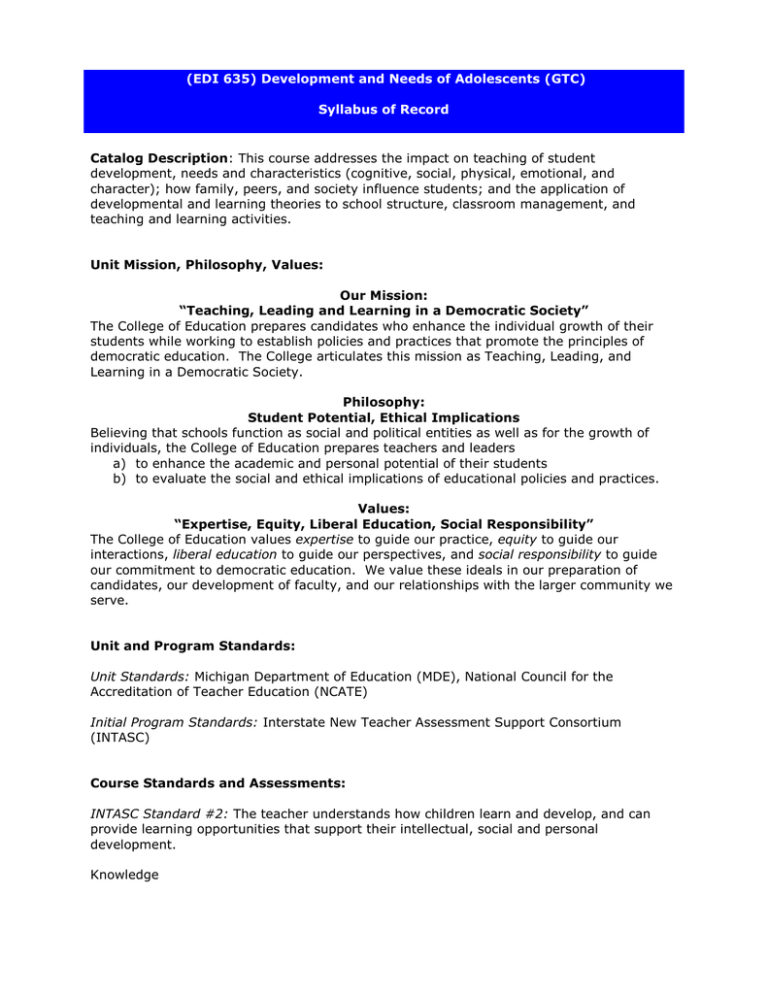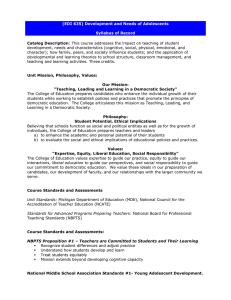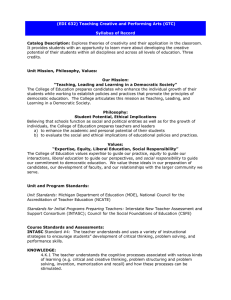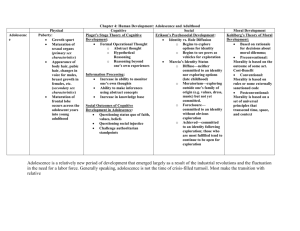(EDI 635) Development and Needs of Adolescents (GTC) Syllabus of Record
advertisement

(EDI 635) Development and Needs of Adolescents (GTC) Syllabus of Record Catalog Description: This course addresses the impact on teaching of student development, needs and characteristics (cognitive, social, physical, emotional, and character); how family, peers, and society influence students; and the application of developmental and learning theories to school structure, classroom management, and teaching and learning activities. Unit Mission, Philosophy, Values: Our Mission: “Teaching, Leading and Learning in a Democratic Society” The College of Education prepares candidates who enhance the individual growth of their students while working to establish policies and practices that promote the principles of democratic education. The College articulates this mission as Teaching, Leading, and Learning in a Democratic Society. Philosophy: Student Potential, Ethical Implications Believing that schools function as social and political entities as well as for the growth of individuals, the College of Education prepares teachers and leaders a) to enhance the academic and personal potential of their students b) to evaluate the social and ethical implications of educational policies and practices. Values: “Expertise, Equity, Liberal Education, Social Responsibility” The College of Education values expertise to guide our practice, equity to guide our interactions, liberal education to guide our perspectives, and social responsibility to guide our commitment to democratic education. We value these ideals in our preparation of candidates, our development of faculty, and our relationships with the larger community we serve. Unit and Program Standards: Unit Standards: Michigan Department of Education (MDE), National Council for the Accreditation of Teacher Education (NCATE) Initial Program Standards: Interstate New Teacher Assessment Support Consortium (INTASC) Course Standards and Assessments: INTASC Standard #2: The teacher understands how children learn and develop, and can provide learning opportunities that support their intellectual, social and personal development. Knowledge 2.K.1 The teacher understands how learning occurs-how students construct knowledge, acquire skills, and develop habits of mind-and knows how to use instructional strategies that promote student learning. 2.K.2 The teacher understands that students’ physical, social, emotional, moral and cognitive development influence learning and knows how to address these factors when making instructional decisions. 2.K.3 The teacher is aware of expected developmental progressions and ranges of individual variation within each domain (physical, social, emotional, moral and cognitive), can identify levels of readiness in learning, and understands how development in any one domain may affect the performance in others. Dispositions 2.D.1 The teacher appreciates individual variation within each area of development, shows respect for the diverse talents of learners, and is committed to help them develop selfconfidence and competence. 2.D.2 The teacher is disposed to use students’ strengths as a basis for growth, and their errors as an opportunity for learning. Performances 2.P.1 The teacher assess individual and group performance in order to design instruction that meets learners’ current needs in each domain (cognitive, social, emotional, moral, and physical) and that leads to the next level of development. 2.P.2 The teacher stimulates student reflection on prior knowledge and links new ideas to already familiar ideas, making connections to students’ experiences, providing opportunities for active engagement, manipulation, and the testing of ideas and materials, and encouraging students to assume responsibility for shaping their learning tasks. 2.P.3 The teacher accesses students’ thinking and experiences as a basis for instructional activities by, for example, encouraging discussion, listening and responding to group interaction, and eliciting samples of student thinking orally and in writing. Common Course Assessment: Adolescent Research Project Major Topics: Perspectives and adolescence Puberty and biology Cognitive growth and education Identity and socio-emotional development Family relationships Peers and youth culture Teenage sexuality Problem behaviors and interventions Course Knowledge Base: Duffy, Karen G. (2004). Adolescent Psychology. (4th ed.). Dubuque, IO: Mc Graw-Hill Knowledge BaseArmstrong, T. (1994). Multiple Intelligences in the Classroom. Alexandria, VA: Association of Supervision and Curriculum Development. Bruer, J.T. (1999). In search of brain-based education. Phi Delta Kappan. 80(9), 649-657. Caine, R. N. & Caine, G. (1994). Making connections: Teaching and the human brain. Menlo Park, CA: Addison-Wesley. Dubas, J.S., Garber, J.A., & Peterson, A.C. (1991). The effects of pubertal development on achievement during adolescence. American Journal of Education. 99(4), 444-458. Dunn, R. (1995). Strategies for educating diverse learners. Fastback 384. Bloomington, IN: Phi Delta Kappa Educational Foundation. Eccles, J.S., Midgley, D., Wigtield, A., Buchanan, C.M., Reuan, D., Flanahan, C., & Maclver, D. (1993). Development during adolescence: the impact of stage-environment fit in young adolescents’ experiences in schools and in families. American Psychologies, 48, 90-101. Elkind, D. (1978). All grown up and no place to go: Teenagers in crisis. Reading, MA: Addison-Wesley. Fitzgerald, R. (1996). Brain-compatible teaching in a block schedule. School Administrators,. 53(8), 20-21, 24. Gardner, H. (1996). Multiple intelligences: myths and messages. International Schools Journal. 15(2), 8-22. Goodlad, J., Soder, R., & Sirotnik, K. (Eds.). (1990). The moral dimensions of teaching. San Francisco: Jossey-Bass. Laziar, D. G. (1992). Teaching for multiple intelligences. Bloomington, IN: Phi Delta Kappa Educational Foundation. Marzano, R.J. (1992). A different kind of classroom: Teaching with dimensions of learning. Alexandria, VA: Association of Supervision and Curriculum Development. Schurr, S.L. (1995). Prescriptions for success in heterogeneous classrooms. Columbus, OH: National Middle Schools Association. Stinberg, L. (1996). Beyond the classroom: Why school reform has failed and what parents need to do. New York: Simon & Schuster. Vaughn, S., Bos, C. S. Schumm, S. (1997). Teaching mainstreamed, diverse, and at risk students in the general education classroom. Needham Heights, JA: Allyn & Bacon. Walker, H. (1998). First steps to prevent antisocial behavior. Teaching Exceptional Children. 30(4), 17-19.



